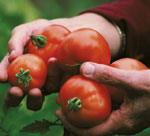Tomato and pepper growing in the Pacific Northwest
by David Johnson, Crop Horticulturist
This article was originally published in May 2003

Having grown tomatoes locally, I’d like to offer a few ideas for home growers wishing to find the best fit for our local region. For anyone who has been at this game more than a few years, you soon discover that some just aren’t suited to our nearly warm weather. Here are a few suggestions.
Warm nights
Surprisingly, tomatoes do not need full sunshine to thrive. I thought I knew all about it when I completed my degree from WSU. The next summer, a friend of my mother told me he planned to plant tomatoes under his cherry tree in the back yard.
I thought it was so foolish and said to him, “Those doggone tomatoes cannot ripen in the shade.” He smiled and said, “Well, I think they will do just fine.” Guess what? He was right. The tomatoes did very well and set a lot of red and ripe fruit. Peppers probably are not quite so shade tolerant.
What tomatoes really need are warm night temperatures. Yes, our days often get warm enough, but tomatoes originate in a climate which stays pretty warm in the evening as well. Here, we get about two weeks of such weather, in mid-July as a rule. The optimal temperature range for tomatoes is 74 to 84 degrees. For peppers, it’s a bit higher, perhaps 80 to 90 degrees, hence peppers are very hard to grow around here.
Sandy Soil
Create a raised bed of very sandy soil medium (at least 50 percent sand). Bring the pH up to about 6.5 with Dolomite lime (see advisory on lime, “The scoop on organic fertilizer,” Sound Consumer, March 2003). Add some very coarse gravelly sand to the surface; it allows the plants to sprawl and the fruit will remain dry.
Spacing — do not crowd
This is important, mucho importante! Do not crowd tomatoes. Tomatoes tend to be quite rampant, especially the non-determinate types (these plants grow rampantly and need more pruning). Determinate type tomatoes (self-topping, which means branches don’t grow continually) are much more compact growers and tend to set their main crop at one time. Spacing for determinate plants should be no closer than 36 inches apart.
For non-determinate tomato plants, 48 inches is best. Crowding the plants will create cooler, damper conditions and encourage the development of blight sooner in the fall season. For peppers, 18 inches is usually plenty. Days to maturity Most catalogs will list the note “days to maturity.” Remember, this is an estimate based on performance in another part of the country.
If a Beefsteak tomato, say, takes 75 days to mature in Fresno, California, it does not follow that the same fruit will be ready in Seattle in 75 days. As a rule, add 25 percent to the days to maturity and you’ll be closer to what will happen here.
For seed companies located in the Northwest, like Territorial, the dates may be quite accurate, but that’s an exception to the rule. In a local garden center, I’d avoid any selection that takes more than 72 days according to the tag.
Worth the trouble
From my own experience, the following varieties work well in the lower Puget Sound region —
- Santa Cruz Kada and Jitomate Bullito — spaghetti paste-type, good in cooler regions;
- Black Prince — a dark reddish/black salad tomato, very productive;
- Goliath — a beefsteak type tomato that ripens very well (indeterminate);
- Siletz — a beefsteak-type (determinate);
- Striped Green Zebra — a yellow green striped salad tomato, the very best tasting tomato I’ve ever tried for fresh eating;
- Sungold — large golden cherry-type tomatoes, very sweet.
When selecting young plants, buy them in the four packs early on and keep them inside until the soil temperature reaches 60 degrees. Avoid buying large plants that are already in bloom or have that purplish look caused by chilling injury. Ideally, the young plants should have a bright green color. The latest date to start plants at home from seed would be about mid-March.
Pepper plants
The only two I can recommend at this point are as follows:
- Healthy — a Russian variety, tolerates cool weather;
- Hungarian Yellow Wax — fairly good hot pepper, tolerates cool weather.
In closing, be patient setting the young plants out. Wait until the soil temperature is about 60 degrees. In the meantime, keep the tomato plants in out of raw weather, in the sunniest window or sheltered place you can create. Chilling injury will set the plants back, and you will gain nothing by planting too early. This is even more so with peppers.
